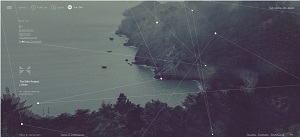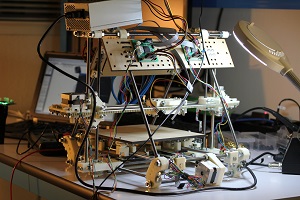Taipei Digital Art Festival embodies spirit of collaboration
By Yali Chen Now in its 10th year, the festival running from November 13 until November 22 at the Songshan Cultural and Creative Park in Taipei showcased interactive art programs combining contemporary art forms and the latest production techniques. The 10-day event also features a wide range of exhibitions on animated films, interactive art installations, GIFs (Graphics Interchange Formats), and video games, as well as lectures, seminars, competitions, electronic music concerts, and avant-garde performances by talented artists from Taiwan and overseas. According to event curator FabLab Dynamic, the development of new technologies enables ordinary people to get a better understanding of artistic creation. This year’s festival, themed Digitopia, attempts not only to alert the public to the coming of the era in which digital technology and social life intertwined with each other, but also to expand spaces for art and to push the boundary of creativity. We think everyone is an artist; more importantly, all are equal before the arts, said the curatorial team FabLab Dynamic, which aims to demonstrate the transdisciplinary nature of digital art and collaborative culture through breakthrough innovations and new exhibition forms. Jonathan Dagan, better known in the music business as j.viewz, is a Brooklyn-based songwriter, producer, and visual artist. He not only constantly pushes the boundaries in the creative world, but also creates multilayered songs that blend raw elements with electronic music through his use of analog tapes, recordings of nature, and sounds sent by his audiences. His musical experiment is the renowned DNA Project, a website presenting the step-by-step making of his album in real-time. The DNA Project won the prestigious Cannes Silver Lion Award and was nominated for the Webby Awards. Dagan’s second full-length album, Rivers and Homes, followed a similar concept where subscribers had access to each song as soon as it was ready. He designed a visual journal at the end of this project, which he eventually used to make the package of the album. In 2012, the album was nominated for the Grammy Award for Best Recording Package, an MTV O Music Award and a UK Music Video Award. His latest release, Far Too Close, was also nominated as Song of the Year for 2014 by Israeli music station Galgalatz. With the DNA Project, Dagan invited his fans of the Digital Art Festival Taipei to follow his creative process in its entirety, providing access to the people, places and sounds that inspire each song, as well as exclusive videos of his writing process, recording sessions, and innermost thoughts during his creation of new music. Another praiseworthy program is "PPES Reading Hut" by WikiHouse, led by young British architect Alastair Parvin. As an open-source building system, WikiHouse not only satisfies various needs but also responds to contemporary housing problems by exploring the relationship between architecture and humanistic landscapes as well as by simplifying the process of design and production. The small, partially enclosed reading space, "PPES Reading Hut," is designed based on simple open-source concepts. It also uses low-energy techniques to meet individual users’ needs. The Graduate Institute of Architecture of the National Chiao Tung University (NCTU) in Hsinchu and the Association of Humanitarian Architecture in Taiwan took charge of the infrastructure as well as structural and exterior design of this project. Noise Kitchen, the Department of Wood Based Materials and Design of the National Chiayi University, Woodworking Training Design Research Center of National Taipei University of Technology, College of Design of Chaoyang University of Technology, and Maker Union 2015 International Competition Workshop for Emerging Student Designers in Taiwan also participated in the structure CNC cutting process. Visitors were invited to take part in this project and accomplish Taiwan’s first "Wikihouse" with concerted efforts, which embodies the spirit of collaboration highlighted by this year’s festival. As part of the PPES Reading Hut, the finished work was donated to the Beiping Elementary School in northern Taiwan’s Hsinchu County after the festival had ended. In 2004, British engineer-mathematician Adrian Bowyer invented the first 3D printer named RepRap (Replicating Rapid Prototyper) capable of self-production and self-replication. RepRap was the first of the low-cost 3D printers, and Adrian started the community-oriented, open-source 3D printer revolution. RepRap is unique because it was designed to print copies of itself. It has become the most widely-used 3D printer among the global members of the Maker Community. In addition, thanks to its open-source feature, RepRap allows interested parties to download, examine, and improve it. As a result, the concept of "machine-produced machine" has become a cycle of unlimited sharing. The 3D printer in this year’s exhibition continued producing the components of other 3D printers, thereby generating an endless production process in which the produced printers would in turn serve the role of producers. Safecast is a global volunteer organization established a week after the Japan 3/11 earthquake. In collaboration with Tokyo Hacker Space, Keio University and MIT Media Lab, the organization has collected radiation measurements throughout Japan, including those within the danger zones. So far, this organization has accumulated more than 2,500,000 readings. Combining with the previous readings gathered in Western Taiwan, this year’s project would result in a more comprehensive radiation map of Taiwan by collecting new radiation levels in Yilan, Hualien, Taitung, and Orchid Island. An additional bonus show, "Render Ghost," is an interactive performance designed by performing art company CBMI – this year’s Digital Art Performance Award winner. Without any performers, this show combines dry ice, laser beams, and powerful fans as well as innovative light and sound effects to create an interactive artistic experience. Wearing head-mounted displays and dust-free garments, the audiences become performers on the digital interface-like stage, wandering around the space where the digital and virtual worlds converge. This year’s event curator FabLab Dynamic believed that the mesmerizing interplay between light and sound would certainly convey an unforgettable futuristic atmosphere to make the audiences’ imagination run wild. The interactive performance from November 20 through November 22 wrapped up the 2015 Digital Art Festival Taipei.
STAFF WRITERSince 2006, the Digital Art Festival Taipei initiated by the Department of Cultural Affairs (DCA) has become an annual gala event of art in Taipei. The festival aims to promote cutting-edge forms of digital art and deal with a series of issues between human creativity and technology.
 One highlight of this year’s festival is the "The DNA Project" – a 10-month experience that invites fans to be a part of the album-making process. After the album is done, listeners can explore the DNA of the entire album, tracing back step by step to the genesis of each song.
One highlight of this year’s festival is the "The DNA Project" – a 10-month experience that invites fans to be a part of the album-making process. After the album is done, listeners can explore the DNA of the entire album, tracing back step by step to the genesis of each song. In recent years, 3D printing technology has become the focus of attention. One new highlight of this year’s event is the "Derivative Chain" – a 3D printer that continually produces the components of other 3D printers to generate an endless production process. This functioning art piece is operated in conjunction with various "maker spaces," where like-minded individuals can attend DIY workshops to share ideas and techniques.
In recent years, 3D printing technology has become the focus of attention. One new highlight of this year’s event is the "Derivative Chain" – a 3D printer that continually produces the components of other 3D printers to generate an endless production process. This functioning art piece is operated in conjunction with various "maker spaces," where like-minded individuals can attend DIY workshops to share ideas and techniques.With more than 100 volunteers working in different regions of the world, Safecast aims to empower people with data about their environments. After the 3/11 earthquake and subsequent nuclear radiation at Fukushima Diachi, it became obvious that the public wanted more freely available open data. As a result, Safecast has built a radiation sensor network, gathered radiation level data from across Japan, and shared radiation levels publicly, thereby enabling people worldwide to both contribute and freely use the data collected.

![Taiwan.gov.tw [ open a new window]](/images/egov.png)
